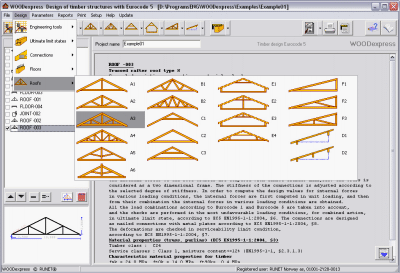
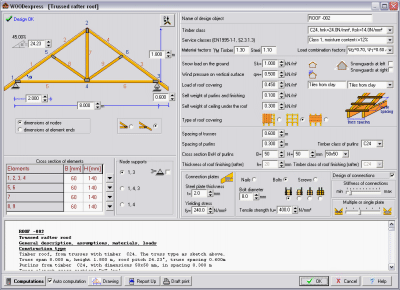
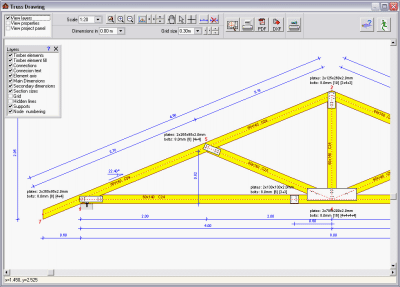
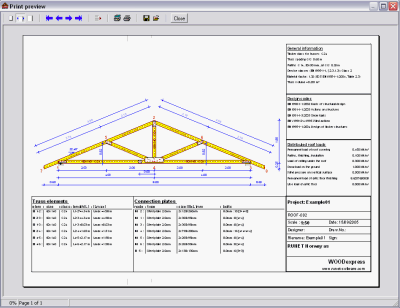
 Roofs
Roofs
- mono-pitch roofs
- coupled roofs
- close coupled roofs
- trussed rafter roofs
- attic trusses
- trusses with carpentry joints
The design is based on a finite element analysis of the truss structure. The truss is considered as a two dimensional frame structure, and the stiffness of the connections is adjusted according to the selected degree of stiffness. The natural frequencies of the roof trusses are computed from a dynamic analysis.The loads are evaluated according to Eurocode 0 and 1.
All the load combinations are taken into account.
The checks are performed for the most unfavourable loading conditions, for combined action in ultimate limit state of design, according to EN 1995-1-1:2008, § 6.
The deflections are checked in serviceability limit condition, according to EN 1995-1-1:2008, § 7.The connections are considered as nailed, bolted or screwed joints with metal plates and are dimensioned according to EN 1995-1-1:2008, § 8. Automatic generation of truss drawings.
Detailed drawing of the truss structure and the connections are automatically produced. A specialised CAD modulus is included to customise, preview and print the drawings. Export to DXF and PDF files.
Dimensions
You specify the main roof dimensions (length, high or pitch). You can choose to specify dimensions at nodal points or at element ends.
Cross-section sizes are chosen from the various tables included in the program. Tables with section sizes from different European countries are included in the program, and you can also specify you own.
End cantilevers can be added on the sides.
Supports at various nodes can be selected.
Roof covering loads
The program includes most of the common roof covering materials. You can also specify your own types of roof loading.
Snow loading is evaluated according to Eurocode 1, EN 1991-1-3-2003. You specify the characteristic snow load value on the ground in [kN/m²]. Snow guards at the right or left side can be specified.
Wind loading is evaluated according to Eurocode 1, Actions on structures, EN 1991-1-4:2005. You specify the wind pressure on a vertical surface in [kN/m²].
Load combination is according to Eurocode EN 0, Basis of structural design EN 1990:2002. You can adjust the action and load combination factor.
Connections properties you can specify are:steel plate type, regular or BMF, plate thickness, the degree of stiffness of connections, the type and size of the connection nails.
You can also select to use single or multiple plates in the joints with more than two members.
Splices are designed automatically for long timber members.
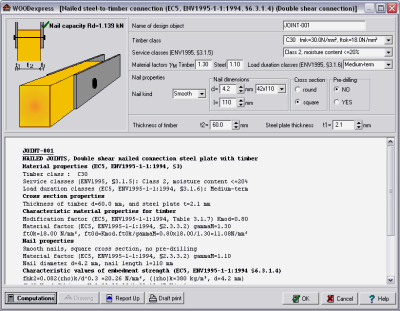
 Connections
Connections
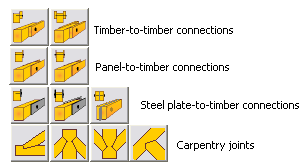
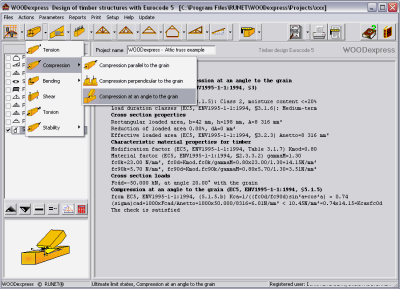
You can design various types of bolted, nailed and screwed connections. Specify the properties of the bolts, nails or screws, and the properties of the connection wood or metal plate, and the Capacity Rd is computed according to Eurocode 5, EN 1995-1-1:2004 § 8.
 Ultimate limit states
Ultimate limit states
Design of various cases of single or combined action according to Eurocode 5, EN 1995-1-1:2004 § 6, round and rectangular sections.
The design objects are independent objects and each one has its own drawings, material properties and computations
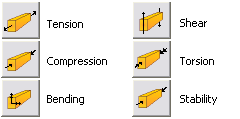
Structural fire design
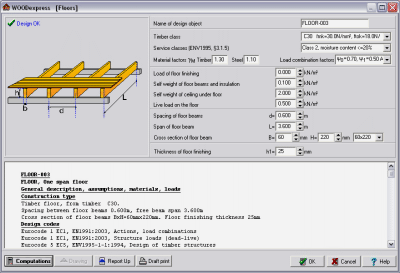
Structural fire design is performed for every stress case. The structural fire design is performed according to Eurocode 5, part 1-2, reduced cross section method..
 Floors
Floors
The internal forces are computed at the ends and the middle span of the floor beam and the elastic bending deformations at midspan, for all the load combinations according to Eurocode 0, 1 and 5.
All the checks of Eurocode 5, EN 1995-1-1:2004, § 6 are performed in ultimate limit state.
The deflections are checked in serviceability limit state according to Eurocode EN 1995-1-1:2004, § 7.
The Eurocode EN 1995-1-1:2004, § 7.3. considerations are taken into account for the check of beam vibrations.
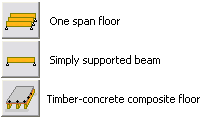
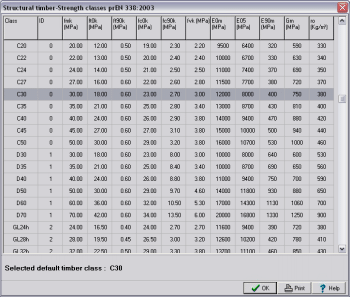
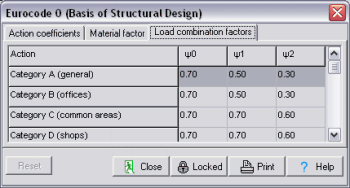
 Parameters
Parameters
From the menu parameters you can adjust the default dimensions, section sizes, material properties, loads and code parameters.
Timber strength classes from tables according to EN338:2003 Softwood/Hardwood, 1194:2000 Glulam, included in the program. You can also specify user defined tables with timber strength classes.
Section properties tables according to the Eurocode standard EN 1313-1, from European countries, are included. You may also specify user defined tables with timber sections.
The most common used roof covering loads are included in the program. You can modify or add roof loads.
The action coefficients for permanent and variable loads in unfavourable loading conditions according to Eurocode 1,5. The user can adjust the action coefficients.
Eurocode version
For timber design, snow and wind loads you can choose the Eurocode version to be used in the design, according to which code is applied in your country.
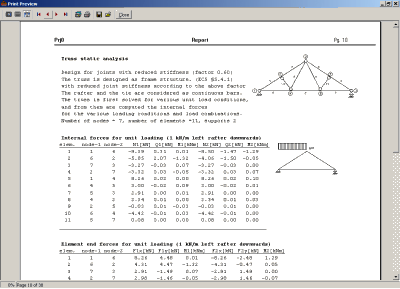
 Report
Report
A detailed report is produced, showing analytically all the computations, drawings, design steps, design assumptions and references to the corresponding design code paragraphs. Warnings in red appear in the report in cases of inadequate design.
The report contains all the objects that are checked in the design objects window. The order of the objects appearing in the report can be adjusted.
Adjustments for the report, font, margins, logo of caption or footnote, etc. can be done from the menu Report Setup.
The report can be exported to PDF and Word format.
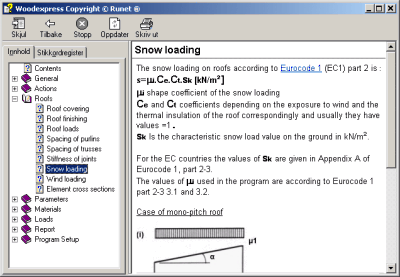
 On line help A context-sensitive Help system guides you through the use of the program and the Eurocode provisions. The program includes an online user’s manual and frequently asked questions (F.A.Q.).
On line help A context-sensitive Help system guides you through the use of the program and the Eurocode provisions. The program includes an online user’s manual and frequently asked questions (F.A.Q.).
 User’s manual included
User’s manual included
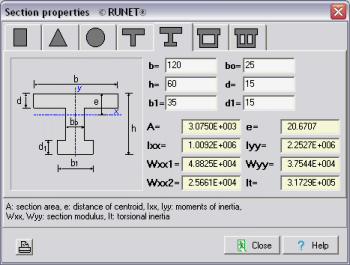
 Engineering tools
Engineering tools
n addition various engineering tools are included as, unit conversion, section properties, area computations, reinforcing bar properties, lateral earth pressure coefficients
- Unit conversion
- Area calculation
- Section properties calculation
- Rolled steel shapes

























